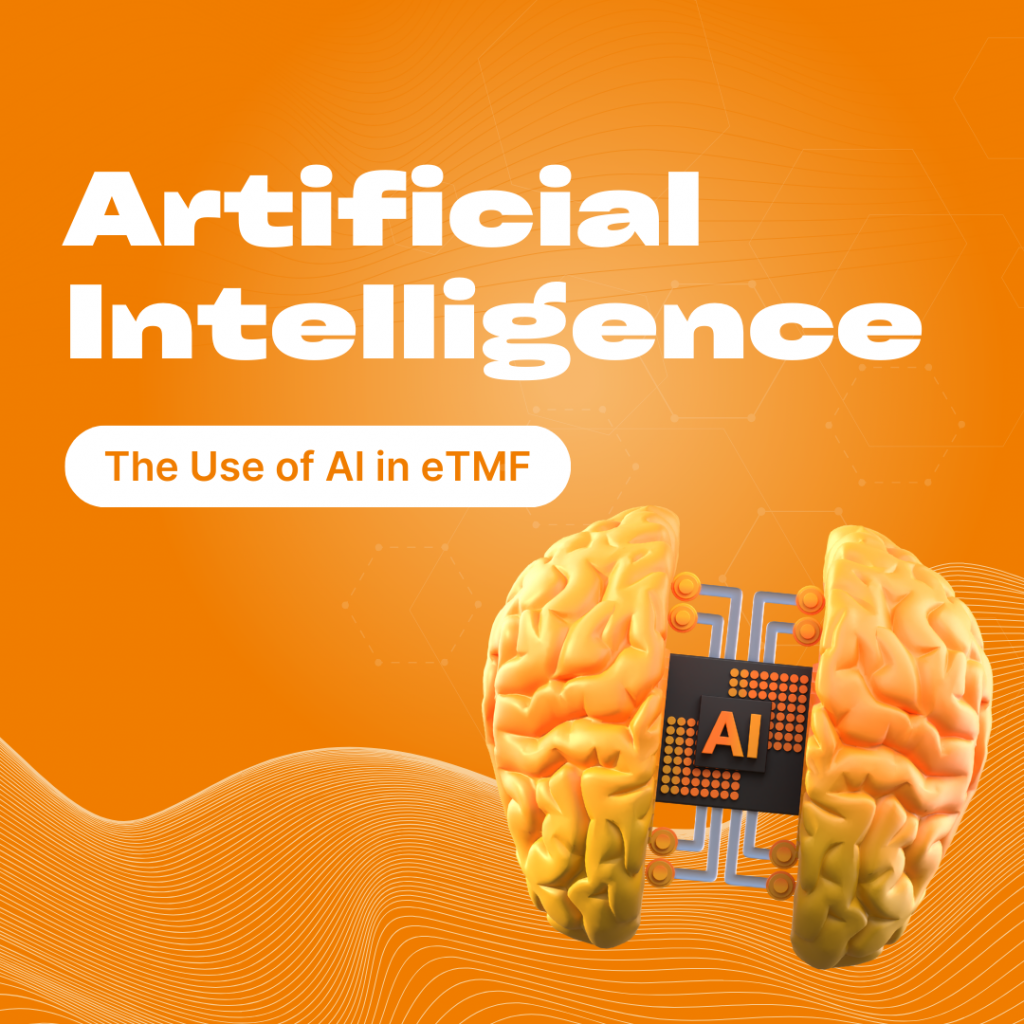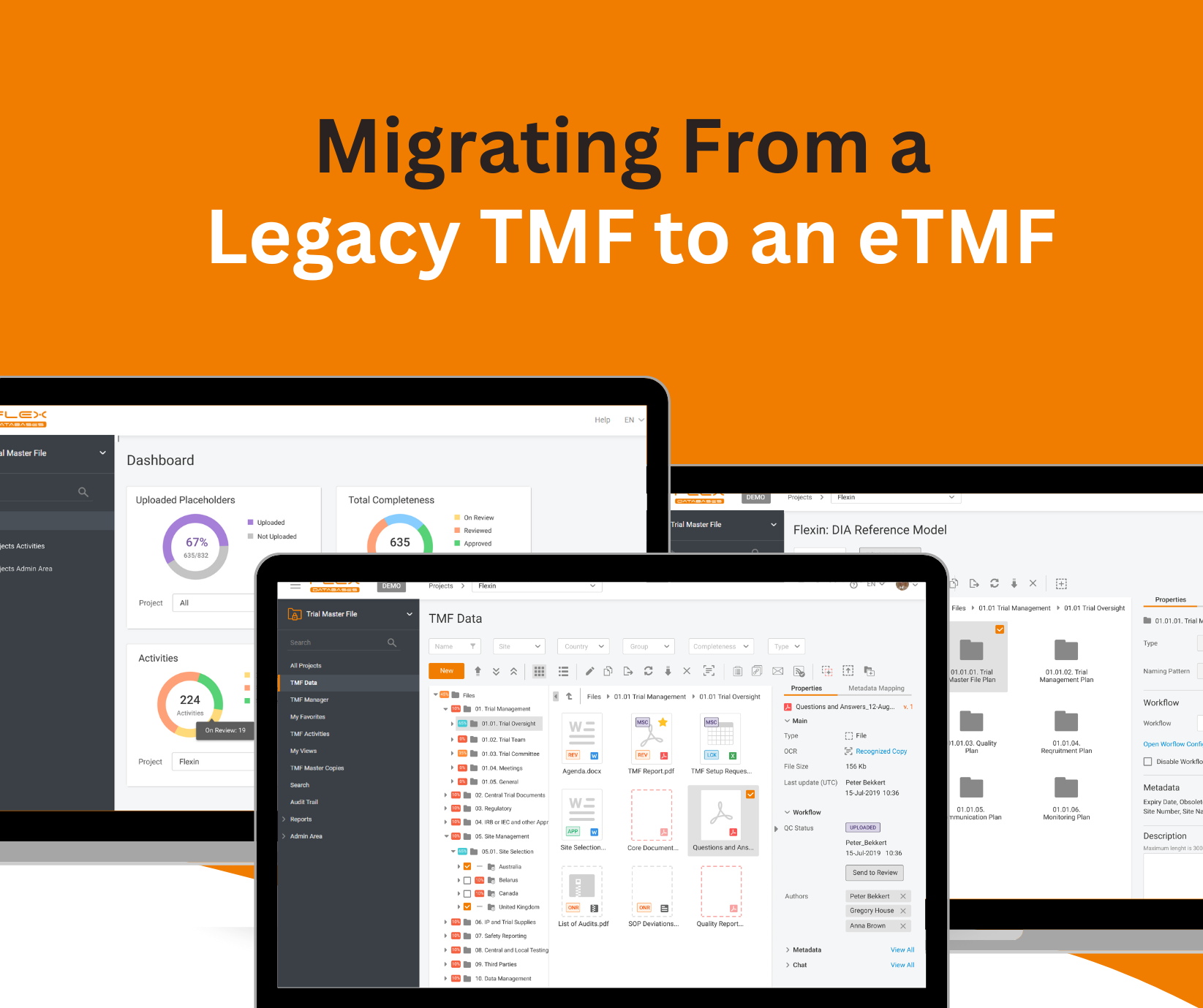The Use of AI in eTMF
May 27, 2024

While AI might sound futuristic, its role in document management is simply the next step in automation. Imagine a system that automatically files the documents and assigns relevant metadata. This is now possible with Flex Databases’ AI-powered solution.
But before we delve deeper, let’s address a key point: AI is not a magic bullet. It’s a tool that enhances existing workflows.
Why use AI in eTMF?

In the industry of clinical research, where mountains of documents are a daily norm, the integration of Artificial Intelligence has many core advantages, such as:
- Efficiency – AI can process documents much faster than humans, significantly reducing time and efforts.
- Cost Reduction – automating the filing process leads to significant cost savings, especially in large-scale studies.
- Real-time Processing – AI works 24/7, providing real-time filing and metadata tagging as soon as documents are uploaded.
- Scalability – As the volume of documents grows, AI can easily scale up to handle increased loads without the need for additional staff.
- Focus on Core Activities – with AI handling the routine task of filing, clinical research staff can focus on more critical activities that require human judgement and expertise.
- Accuracy – AI algorithms are trained to identify and classify documents with high precision to reduce errors in filing and metadata assignment.
- Compliance – AI can help maintain compliance with regulatory requirements by ensuring that documents are correctly filed, and metadata is accurately applied.
How to use AI in TMF?
Uploading, sorting and managing documents has become much simpler, especially with the help of artificial intelligence. Flex Databases AI allows you to upload a document in various ways – like taking a photo of the document with your phone and emailing it directly into eTMF, or simply dragging and dropping files from your computer.
Before AI, getting a document into the TMF meant manual work. People had to organise files into the right folders and add metadata manually, which is time-consuming and may lead to mistakes. But with AI, things have changed. Once you upload a document, AI takes care of placing it in the correct folder and assigning metadata. Thus you can save efforts and focus on more important tasks.
Here is how you can upload documents with the help of AI
- Take a picture of the document with your phone – email to eTMF.
- Email any document from your computer or emails into eTMF.
- Drag and drop a document from your computer into eTMF.
- Upload a document through one of the eTMF interfaces.
How to reduce the risks of AI mistakes?
While AI automates document filing and metadata assignment, minimising the risks is the key factor for compliance and efficiency. Here’s how we address this:
Co-pilot Control
Flex Databases’ AI eTMF solution provides a “co-pilot” feature that allows users to act as partners with the AI.
We added co-pilot mode with mathematical function behind it that evaluates the confidence of AI processing end result, then flags it for the users to check, if needed.
This means having people do a quality check after the AI has done its job. There are special mathematical methods to measure the confidence level in the AI’s processing accuracy. For instance, in our system for AI-driven filing of documents in TMFs (Trial Master Files), you can set it so that if the confidence level is below 95% (for example), it gets flagged for a human to review and approve.
𝐘𝐨𝐮 𝐬𝐭𝐢𝐥𝐥 𝐬𝐚𝐯𝐞 𝐦𝐨𝐬𝐭 𝐨𝐟 𝐭𝐡𝐞 𝐭𝐢𝐦𝐞 𝐨𝐟 𝐲𝐨𝐮𝐫 𝐞𝐦𝐩𝐥𝐨𝐲𝐞𝐞𝐬, 𝐛𝐮𝐭 𝐝𝐨𝐧’𝐭 𝐜𝐨𝐦𝐩𝐫𝐨𝐦𝐢𝐬𝐞 𝐨𝐧 𝐭𝐡𝐞 𝐪𝐮𝐚𝐥𝐢𝐭𝐲.
Data Quality
Using high-quality data is crucial for a successful AI model. That’s why we take great care in preparing the data used to train the AI. This ensures artificial intelligence learns from accurate and complete information. This careful approach minimises the chance of the AI picking up any mistakes from the data. As a result, the AI performs better when filing documents in real-world situations.
AI driven TMF is available out-of-the-box with a pretrained AI model to start working with it right away after implementation, but we also train AI on the actual client data during implementation to improve confidence level and the end result of AI model usage.
Metadata
AI driven TMF not only places the documents in the correct folder saving time on filing documents, it also assigns correct metadata to documents like date of the document, effective date, expiration date, you name it, as well as sites, countries, etc. With metadata generative AI is used to generate metadata based on the content of the document.
By combining these strategies – user control through the co-pilot feature, high-quality training data, and a focus on accurate metadata – we significantly reduce risks associated with AI-powered document filing.

Data Security
One of our top priorities is to protect the clients’ information. We utilize local servers to store your data, keeping it within your control and out of the public cloud.
Unlike public AI models like ChatGPT, where data from various users might be stored together, we prioritize client’s privacy and data security. The data remains secure with local servers, not someone else’s cloud. Moreover, separate servers dedicated solely to AI provide additional levels of security.
How do we prevent data mixing during processing?
- Separate Servers with Protected Connections. Our AI runs on separate, local servers within the EU, US, or a location based on your region. You can be confident your data stays within your geographical area. A secure, encrypted connection protects data transfer between your server and the AI server.
- Dedicated Processing Queues. Each client has their own dedicated queue for AI processing requests.
Validation

Validation is another cornerstone of our commitment. We provide thorough validation support, including validation of the AI models for guaranteed compliance.
Flex Databases provides supplier documentation to be included in the Client’s validation package.
- Validation certification for baseline module versions certifying pre-validated status of the system ready to be implemented by end user for intended use.
- User Requirements Specification.
- IQ documentation.
- Traceability Matrix.
- OQ Testing Summary Report (client-specific configuration if configured by Flex Databases).
- Maintenance Plan (support, backup, DRP, maintenance procedures by Flex Databases).
- User Acceptance Testing scenarios.
- Training Certificates.
- Vendor Qualification supportive documents:
- QMS Master Index.
- CVs/JDs.
- 21 CFR Part 11 Assessment .
- Other upon request.
Watch the webinar with demo of AI by Flex Databases and AI validation by Flex Databases and its partner Deloitte via this link.
Get in touch to see how AI driven TMF works, we will be happy to answer your questions and discuss pricing.



